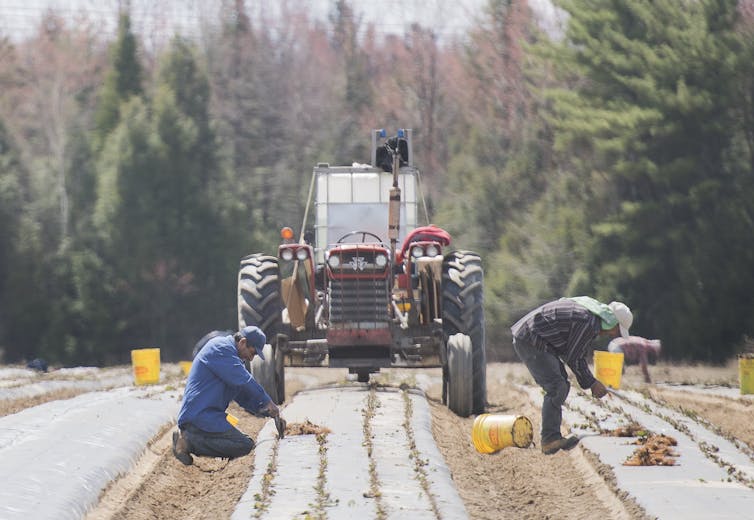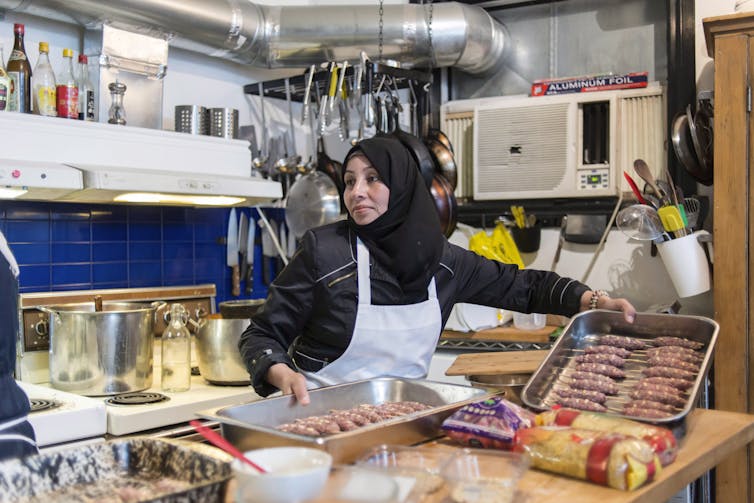
THE CANADIAN PRESS/Graham Hughes
Jennifer Brady, Mount Saint Vincent University and Patty Williams, Mount Saint Vincent University
The COVID-19 pandemic has shone a spotlight on our fraying social safety nets, fragile domestic and global food systems, and the unacceptable precarity faced by newcomers, front-line workers and those living on the economic margins.
Newcomers — recent immigrants, refugees, undocumented workers and international students — are vital to the Canadian economy. We depend on them to provide access to the low-cost foods we have come to expect. But at the grocery checkout, we aren’t paying for the true costs incurred by the ways we grow, manufacture and globally distribute food
Newcomers are often precariously employed and food insecure, and may not have access to the culturally appropriate foods and food practices key to building successful connections in their new communities. Addressing these barriers could help repair some of the cracks in the system.
Newcomers in the food system
Newcomers’ vulnerability is not innate, but created. They are often overlooked because they make up a largely racialized and often economically disadvantaged population.
Newcomers have uncertain living circumstances and access to fewer social supports. They experience higher rates of food insecurity and occupy many of the most under-valued, high-risk, hidden and low-paying jobs in our food systems.

THE CANADIAN PRESS/Graham Hughes
The Seasonal Agricultural Workers Program (SAWP) brings tens of thousands temporary foreign workers into Canada each year, mostly to work on farms. Protections for SAWP workers differ from one province to the next, but generally workers are exempt from regulations for minimum wage, overtime pay or maximum daily work hours, and cannot collect employment insurance even though they make contributions.
Their visas are tied to one employer, making them vulnerable to abuse and job loss if they refuse unsafe work or submit a complaint. Moreover, migrant agricultural workers are viewed as low-skilled, easily replaceable labouring bodies, despite their demonstrable knowledge and skills. This adds to their invisibility.
During the pandemic, the federal government deemed food workers in grocery stores, cafeterias and farms — many of them newcomers — as essential workers, and relaxed regulations to allow international students in these roles to work longer hours. On May 7, Trudeau announced a wage top-up for essential workers, but each province determines who will — and will not — receive this benefit.
Financial and cultural food insecurity
Ultimately, newcomers are situated at the fault lines of Canada’s social safety nets and food systems. The recent outbreaks of COVID-19 at two meat-packing plants in Alberta, staffed mainly by temporary foreign workers and new immigrants, are cases in point.
However, even before the pandemic, newcomers disproportionately experienced poverty and one of its main symptoms, food insecurity.
Beyond the financial barriers to food access, newcomers are regularly unable to access culturally appropriate foods or practise culturally meaningful “foodways,” such as growing, sharing and selling food among their cultural and linguistic communities.
Secure access to culturally appropriate foods, or cultural food security, is an important, but unmeasured and largely unexplored component of food security.
Cultural food security is key
Emerging research, as well as our experience working with newcomer communities, suggests cultural food security is key to newcomers’ sense of identity and personhood, connection to linguistic and cultural communities, nutritional status and grounding in their new communities.
We’ve found that settlement services and programming for newcomers, however, tend to focus on skills training and employment. They often overlook the ways that access to culturally meaningful food and traditional food practices are important to newcomers’ settlement. Moreover, popular depictions of healthy eating are typically Eurocentric and sometimes stigmatizing and offensive.

THE CANADIAN PRESS/Christopher Katsarov
Enabling newcomers to grow culturally diverse food is an opportunity to meet their needs, and to strengthen our food systems. Statistics Canada reports that newcomers start businesses, many of them food businesses. However, compassionate and just settlement support means that we must transform the dominant food system into one that embraces a focus on health, well-being and dignity for newcomers, rather than the commodity-driven, cheap food system.
The Newcomer Kitchen in Toronto has helped newcomers access paid employment and culturally meaningful foods. But more can be done. For example, many newcomers arrive with agricultural knowledge and skills to grow culturally diverse foods, but the capital required to begin production is prohibitive. Assisting newcomers to enter the agricultural sector as owners and operators, rather than as seasonal workers is one way that Canada could address the barriers newcomers face in accessing culturally appropriate food.
Ultimately, policy and program options that address financial and other barriers for newcomers to culturally appropriate foods and food practices are needed to repair the cracks in our social safety nets and the food systems that COVID-19 has brought into the spotlight for many Canadians.![]()
Jennifer Brady, Assistant Professor, Applied Human Nutrition, Mount Saint Vincent University and Patty Williams, Professor, Department of Applied Human Nutrition, Mount Saint Vincent University
This article is republished from The Conversation under a Creative Commons license. Read the original article.

